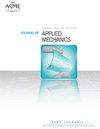细胞集体迁移指状结构的细胞力学
IF 2.8
4区 工程技术
Q2 MECHANICS
引用次数: 0
摘要
指状结构在集体细胞的迁移行为中起着至关重要的作用。然而,指状结构的力学尚未完全理解。在这里,我们构建了一个二维集体细胞迁移模型,并通过实验研究和数值模拟定量分析了指状结构在集体细胞迁移过程中的细胞力学。我们发现,基底刚度、细胞密度、细胞预应力和机械载荷通过调节椭圆足扩展面积、细胞牵引力和细胞运动的集体性,显著影响指状结构的产生和行为。我们发现,最大主应力较高的区域往往会产生较大的指状结构。增加lamellipodia的扩展面积和前导细胞的速度可以促进更高的指状结构的产生。为了定量了解这些机械因素的影响机制,我们采用了基于牵引距离定律的粗粒度细胞模型。我们的数值模拟概括了实验中观察到的细胞速度分布、细胞运动完整性、细胞极化和细胞层中的应力分布。这些分析揭示了指状结构的细胞力学及其在细胞集体迁移中的作用。这项研究为组织工程和再生医学中的集体细胞行为提供了有益的见解,用于生物医学应用。本文章由计算机程序翻译,如有差异,请以英文原文为准。
Cellular mechanics of finger-like structures of collective cell migration
Finger-like structures take crucial roles in migration behaviors of collective cells. However, the mechanics of the finger-like structure has not been fully understood. Here, we constructed a two-dimensional collective cell migration model, and quantitatively analyzed the cellular mechanics of finger-like structures during the collective cell migration through experimental study and numerical simulation. We found that substrate stiffness, cell density, cell prestress, and mechanical loading significantly influence the generation and behaviors of the finger-like structures through regulating the lamellipodia spreading area, cellular traction force, and collectivity of cell motility. We showed that the regions with the higher maximum principal stress tend to produce larger finger-like structures. Increasing the spreading area of lamellipodia and the velocity of leader cells could promote the generation of higher finger-like structures. For a quantitative understanding of the mechanisms of the effects of these mechanical factors, we adopted a coarse-grained cell model based on the traction-distance law. Our numerical simulation recapitulated the cell velocity distribution, cell motility integrity, cell polarization, and the stress distribution in the cell layer observed in the experiment. These analyses reveal the cellular mechanics of the finger-like structure and its roles in collective cell migration. This study provides useful insights into the collective cell behaviors in tissue engineering and regenerative medicine for biomedical applications.
求助全文
通过发布文献求助,成功后即可免费获取论文全文。
去求助
来源期刊
CiteScore
4.80
自引率
3.80%
发文量
95
审稿时长
5.8 months
期刊介绍:
All areas of theoretical and applied mechanics including, but not limited to: Aerodynamics; Aeroelasticity; Biomechanics; Boundary layers; Composite materials; Computational mechanics; Constitutive modeling of materials; Dynamics; Elasticity; Experimental mechanics; Flow and fracture; Heat transport in fluid flows; Hydraulics; Impact; Internal flow; Mechanical properties of materials; Mechanics of shocks; Micromechanics; Nanomechanics; Plasticity; Stress analysis; Structures; Thermodynamics of materials and in flowing fluids; Thermo-mechanics; Turbulence; Vibration; Wave propagation

 求助内容:
求助内容: 应助结果提醒方式:
应助结果提醒方式:


